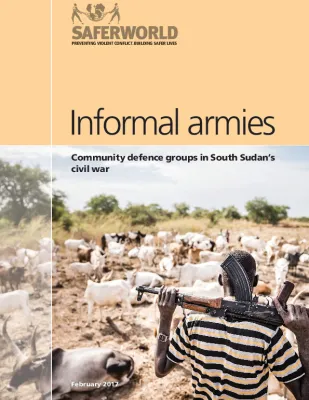The following collection of reflections on aspects of community (and state) security in South Sudan is a valuable example of the type of locally-grounded analysis that has been missing from the last decade of statebuilding engagement. I remember well the excitement and hopefulness that accompanied the signing of the Comprehensive Peace Agreement (CPA) in 2005. But even then, it was striking how the task of addressing underlying grievances from decades of conflict and securing basic public safety and security (both fundamental building blocks for future peace) were relegated by decision makers in the rush to establish an interim period of southern governance. Twelve years later, the human and political cost of side-stepping these ‘fundamentals’ has exceeded our worst imaginings, especially since 2013. Unthinkable violence and abuse has followed, immobilising critical thinking and strategic actions to stop violence and re-set the country on a credible pathway to peace. So in what way are these essays on community defence groups helpful when considering South Sudan’s future? At the outset, they cast a nuanced understanding of some of the different ways communities seek to protect their lives and assets in a context where government institutions either don’t exist, or can no longer be depended upon. This is not to deny the sometimes extraordinary dedication of individuals scattered across South Sudan who offer communities degrees of safety or justice, whether as a police officer, judge or community leader. But in the end, many citizens have no other option but to mobilise, making community defence groups as relevant today as they have been in the past. The collection sheds light on the purpose, complexity and sophistication behind a small number of these groups: the gelweng/titweng, White Armies and arrow boys. Tracing their historical and community roots, the essays untangle the myths and romanticism that have often coloured depictions of their role. Such groups have been heavily shaped by South Sudan’s conflicts and have frequently fallen into the manipulative hands of self-seeking political leaders. They have sometimes helped achieve relative security, or contributed to local peace agreements. More frequently however they have exacerbated violence, presenting harsh dilemmas for vulnerable community members involved. At the same time, defence groups pose critical policy dilemmas for South Sudan’s fledgling state – incorporate, disband or transform them? To ignore them, as the collection makes clear, is not a viable option. The authors make no suggestion that local defence groups can fill the vacuum created by the absence of a functioning state security system. Rather, by highlighting how communities are actually responding to insecurity, the collection’s value lies in helping i ii informal armies: community defence groups in south sudan’s civil war identify entry points, actors and local concerns that should inform measures to restore peaceful coexistence and build a more responsive security system in South Sudan in the long term. The safety of citizens and communities will need to be placed at the centre of these endeavours. Undoubtedly, the journey to transform the drivers and effects of violence will require immense political courage and sustained investment at every level of the state. But moving beyond our traditional approaches to security building – and recognising the significant and complex role that actors outside the state play in community lives – must be central to that process. Let’s begin by putting the realities in front of us and be ready to engage with South Sudan’s informal and emerging state security institutions.
Publisher(s)
Publication year
2017
Abstract
ACCESS
File
Document
Access
“Open” means that the resource is available to view, but please check the weblink for restrictions on use. “Restricted” means that the resource is not openly accessible to all, but you can purchase a copy, or your organisation might have an institutional subscription.
